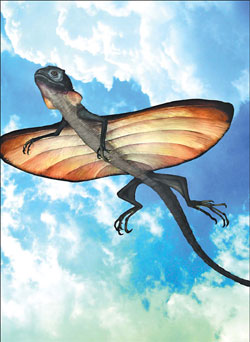| Tools: Save | Print | E-mail | Most Read |
| Dragon Tales |
| Adjust font size: |
Its Chinese name, Xianglong Zhaoi (Zhao's flying dragon), may bring to mind a colossal bugaboo flapping its giant wings across the sky and preying on little rabbits or sheep. But the "dragon" was actually a 15-centimeter-long lizard that could use a membrane spread between eight elongated ribs to glide, possibly feeding on insects or leaves. And it lived 130 million years ago. Chinese archaeologists uncovered the fossil specimen of the gliding lizard in western Liaoning Province in Northeast China in 2005. It contains a complete skeleton and imprints of skin and the membrane, which suggests the animal lived in the early Cretaceous period, about 110 million years ago. Researchers say the lizard was probably at a young ontogenetic stage at the time of death as indicated by the absence of ossified carpals and poorly ossified tarsals. "It is so far the only species that has been found to be able to glide among all extinct species of lizard," said Xu Xing, one of the chief archaeologists in the research team. The new finding was published online in the March 19 issue of the US journal, Proceedings of the National Academy of Sciences. Gliding is regarded as rudimentary flying. Most animals with the ability to glide use a membrane between their toes, or between their body and legs, to stay airborne. However, so far, a similar gliding membrane between elongated ribs has been observed only in a lizard-like fossil from 200 million years ago and in existing dracos gliding lizards found in Southeast Asia, and in Hainan and Yunnan provinces in China, according to Xu, renowned researcher at the Beijing-based Institute of Vertebrate Paleontology and Paleo-anthropology under the Chinese Academy of Sciences. "If you connect all the facts, there is an interesting clue of evolution along the timeline," the researcher said. In the late Triassic era (about 230 million years ago), a remote ancestor of the lizard living in North America and Europe had a similar body structure that enabled it to glide. But it disappeared soon after. After 70 million years, the same feature appeared again on the Xianglong Zhaoi, and was once again lost in recorded history. Today, draco, which has a similar size and body features as the Xianglong Zhaoi, has a moderate population in tropical and subtropical areas in some parts of Asia. The researchers suggest that the rib-supported gliding membranes of different lizard species in different eras arose from convergent evolution. "It means animals of different origins develop similar organs or body structures to adapt to similar environments," Xu explained. For example, the dolphin is a mammal whose ancestors actually lived terrestrially. But to adapt to an oceanic environment, the dolphin has evolved into a swimming "athlete". Xu and his research partners in Shenyang Normal University and Peking University expect to use molecular biology to uncover the development of this evolution in future studies. "We want to know more about the reasons behind it, that is, what specifically stimulated these different species of lizards to develop the same capability for gliding," Xu said. The discovery of Xianglong Zhaoi also suggests that 130 million years ago, western Liaoning Province might have had a similar climate as today's South China and Southeast Asia with tropical thriving forests. The lizard is an animal with about 5,000 species and a history of 200 million years. The generic name of the ancient lizard Xianglong Zhaoi is to honor Dr Zhao Dayu, one of the founders of the Liaoning Paleontological Museum. (China Daily March 20, 2007) |
| Tools: Save | Print | E-mail | Most Read |
 |
| Related Stories |
